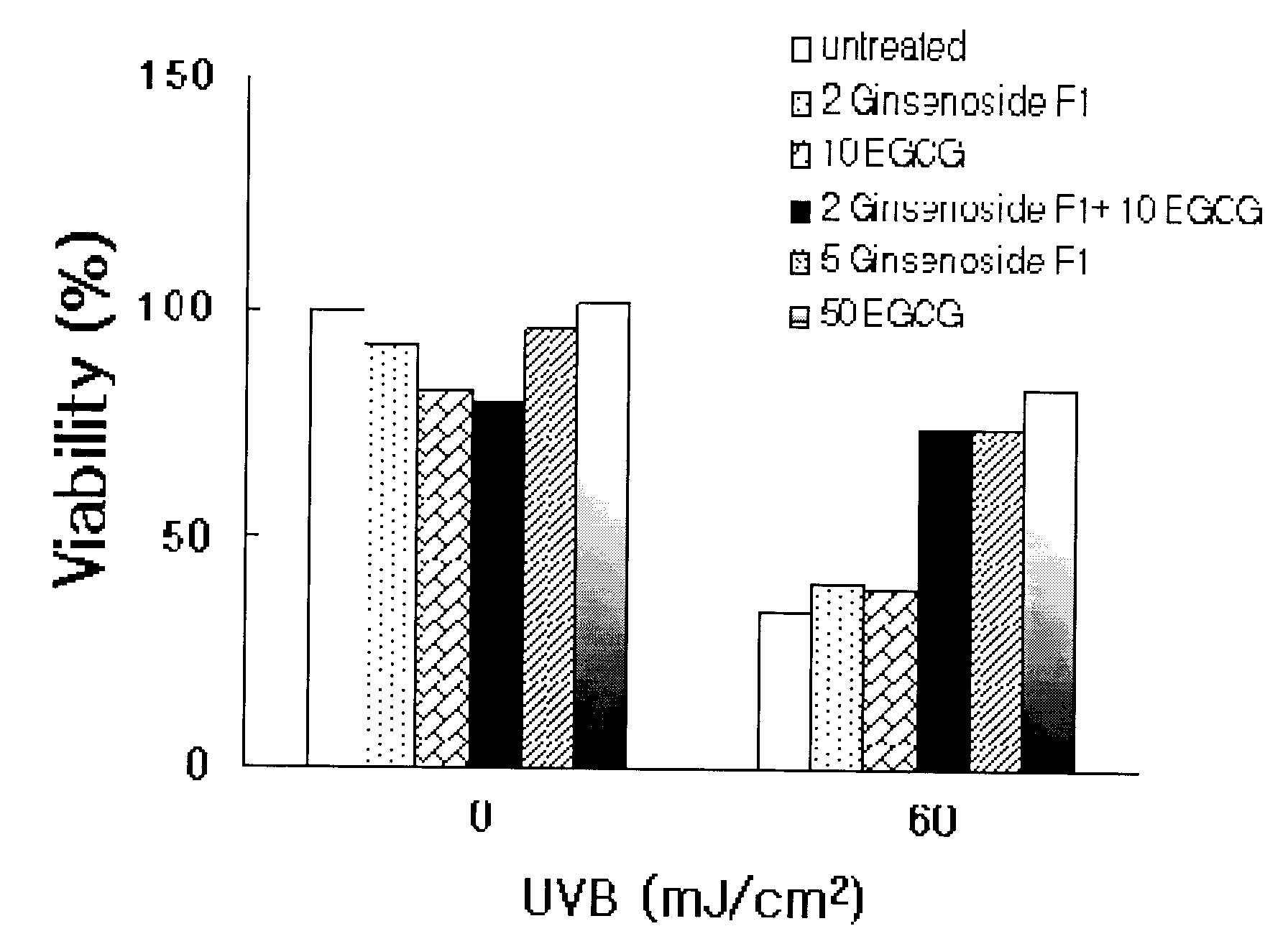Composition Containing Ginsenoside F1 and Egcg for Preventing Skin Damage
a technology of ginsenoside and egcg, which is applied in the field of compositions for preventing skin damage, can solve the problems of skin exposure, cell death, and easy damage to the skin by external irritants, and achieve the effect of preventing the damage of epidermal cells and excellent protection
- Summary
- Abstract
- Description
- Claims
- Application Information
AI Technical Summary
Benefits of technology
Problems solved by technology
Method used
Image
Examples
reference example 1
Preparation of Purified Ginseng Saponin
[0031]4 l of methanol containing distilled water were added to 2 kg of red ginseng (KT&G, six-year-old red ginseng) and refluxed three (3) times, then settled down at 15° C. for 6 days. The crude extracts were passed through filter paper and centrifuged to separate residues and filtrates. The filtrates were concentrated under reduced pressure. The concentration was suspended in distilled water, and then extracted five (5) times with 1 l of ether to remove pigments. The aqueous part was extracted three (3) times with 500 ml of 1-butanol. The obtained 1-butanol parts were treated with 5% KOH and washed with distilled water, then concentrated under reduced pressure. The obtained 1-butanol extract was dissolved in a small amount of methanol and added into a large amount of ethyl acetate. The resulting precipitate was dried, to give 70 g of purified ginseng saponin.
reference example 2
Preparation of Ginsenoside F1
[0032]10 g of the purified ginseng saponin obtained in Reference Example 1 was dissolved in 1000 ml of citrate buffer (pH4.0). 15 g of naringinase separated from Penicillium (Sigma, St. Louis, Mo.) was then added thereto and reacted for 48 hours under stirring in a water bath at 40° C. After the reaction was terminated, the enzyme was deactivated by heating for 10 minutes and the reaction mixture was extracted three (3) times with an equal amount of ethyl acetate, then concentrated. The obtained product was fractionated by silica gel column chromatography using chloroform:methanol (9:1), to give 1.5 g of ginsenoside F1.
example 1
Antiapoptotic Effect of Combined Treatment with Ginsenoside F1 and EGCG in HaCaT Cells
[0033][Step 1] Cell Line and Cell Culture
[0034]Human keratinocyte HaCaT cell line was provided by Dr. N. E. Fusenig (Deutsches Krebsforschungszentrum(DKFZ), Heidelberg, Germany) and cultured in DMEM (Dulbecco's modified Eagle's medium, Gibco 1210-0038) supplemented with 10% fetal bovine serum. Cultures were incubated at 37° C., in humidified air with 5% CO2.
[0035][Step 2] Inhibition of UV-Induced Apoptosis in HaCaT Cells by a Combined Treatment with Ginsenoside F1 and EGCG
[0036]Cell lines cultured in Step 1 were treated with trypsin to give a single-cell suspension and seeded into a 6-well microplate at 2×105 cells per well, then cultured for 24 hours. Subsequently, the culture medium was refreshed with serum-free DMEM and cells were cultured for another 24 hours. The microplate was then treated with 2 μM ginsenoside F1; 10 μM EGCG; a combination of 2 μM ginsenoside F1 and 10 μM EGCG; 5 μM ginsenos...
PUM
| Property | Measurement | Unit |
|---|---|---|
| wavelengths | aaaaa | aaaaa |
| total weight | aaaaa | aaaaa |
| weight ratio | aaaaa | aaaaa |
Abstract
Description
Claims
Application Information
 Login to View More
Login to View More - R&D
- Intellectual Property
- Life Sciences
- Materials
- Tech Scout
- Unparalleled Data Quality
- Higher Quality Content
- 60% Fewer Hallucinations
Browse by: Latest US Patents, China's latest patents, Technical Efficacy Thesaurus, Application Domain, Technology Topic, Popular Technical Reports.
© 2025 PatSnap. All rights reserved.Legal|Privacy policy|Modern Slavery Act Transparency Statement|Sitemap|About US| Contact US: help@patsnap.com



